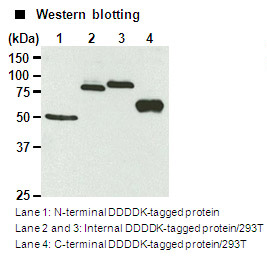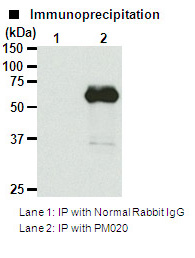| Background |
Epitope tagging is a powerful and versatile strategy for detecting and purifying proteins expressed by cloned genes. Short sequences encoding the epitope tag are cloned in-frame with target DNA to produce fusion proteins containing the epitope tag peptide. Due to their small size, epitope tags do not affect the tagged protein’s biochemical properties. Anti-epitope tag antibodies can serve as universal purification or detection reagents for any tag-containing protein. The DDDDK epitope tag peptide sequence (DYKDDDDK) was first derived from the 11-amino-acid leader peptide of the gene-10 product from bacteriophage T7. The DDDDK peptide has been widely used as a multi-purpose tag, and anti-DDDDK antibodies are optimally suited for identifying, detecting, purifying, and monitoring the expression levels of recombinant DDDDK fusion proteins. |
| Citations |
Western Blotting - Takahashi S et al. The E3 ubiquitin ligase LNX1p80 promotes the removal of claudins from tight junctions in MDCK cells. J Cell Sci. 122, 985-94 (2009)(PMID:19295125)
- Inageda K. Insulin modulates induction of glucose-regulated protein 78 during endoplasmic reticulum stress via augmentation of ATF4 expression in human neuroblastoma cells. FEBS Lett. 584, 3649-54 (2010)(PMID:20667453)
- Itsumura N et al. Compound Heterozygous Mutations in SLC30A2/ZnT2 Results in Low Milk Zinc Concentrations: A Novel Mechanism for Zinc Deficiency in a Breast-Fed Infant. PLoS One. 8, e64045 (2013)(PMID:23741301)
- Kohno T et al. Importance of Reelin C-terminal region in the development and maintenance of the postnatal cerebral cortex and its regulation by specific proteolysis. J Neurosci. 35, 4776-87 (2015)(PMID:25788693)
- Matsuo E et al. Development of reverse genetics for Ibaraki virus to produce viable VP6-tagged IBAV. FEBS Open Bio. 5, 445-53 (2015)(PMID:26101741)
- Makise M et al. The role of vimentin in the tumor marker Nup88-dependent multinucleated phenotype. BMC Cancer 18, 519 (2018)(PMID:29724197)
- Watanabe S et al. MDC1 methylation mediated by lysine methyltransferases EHMT1 and EHMT2 regulates active ATM accumulation flanking DNA damage sites. Sci Rep. 8, 10888 (2018)(PMID:30022091)
- Baba K et al. Gradient-reading and mechano-effector machinery for netrin-1-induced axon guidance. Elife 7, e34593 (2018)(PMID:30082022)
- Chen Y et al. PHLDA1, another PHLDA family protein that inhibits Akt. Cancer Sci. 109, 3532-3542 (2018)(PMID:30207029)
- Murata H et al. c-Jun N-terminal kinase (JNK)-mediated phosphorylation of SARM1 regulates NAD+ cleavage activity to inhibit mitochondrial respiration. J Biol Chem. 293, 18933-18943 (2018)(PMID:30333228)
- Zheng CL et al. Hepatitis B virus core protein dimer‑dimer interface is critical for viral replication. Mol Med Rep. 19, 262-270 (2019)
(PMID:30387827)
- Gao Q et al. A Novel CNGA1 Gene Mutation (c.G622A) of Autosomal Recessive Retinitis Pigmentosa Leads to the CNGA1 Protein Reduction on Membrane. Biochem Genet. in press
(PMID:30652268)
- Pan T et al. USP49 potently stabilizes APOBEC3G protein by removing ubiquitin and inhibits HIV-1 replication. Elife. 8, e48318 (2019)(PMID:31397674)
- Koyano F et al. Parkin-mediated ubiquitylation redistributes MITOL/March5 from mitochondria to peroxisomes. EMBO Rep. 20, e47728 (2019)(PMID:31602805)
- Yamano S et al. Nuclear import of IER5 is mediated by a classical bipartite nuclear localization signal and is required for HSF1 full activation. Exp Cell Res. 386, 111686 (2019)(PMID:31669744)
- Hua R et al. FBXO47 regulates telomere-inner nuclear envelope integration by stabilizing TRF2 during meiosis. Nucleic Acids Res. 47, 11755-11770 (2019)
(PMID:31724724)
- Kobayashi S et al. West Nile Virus Capsid Protein Inhibits Autophagy by AMP-activated Protein Kinase Degradation in Neurological Disease Development. PLoS Pathog. 16, e1008238 (2020)(PMID:31971978)
- Liu C et al. Slx5p-Slx8p Promotes Accurate Chromosome Segregation by Mediating the Degradation of Synaptonemal Complex Components During Meiosis. Adv Sci (Weinh). 7, 1900739 (2020)(PMID:32099749)
- Miyata H et al. Testis-enriched kinesin KIF9 is important for progressive motility in mouse spermatozoa. FASEB J. 34, 5389-5400 (2020)(PMID:32072696)
- Yamamoto YH et al. ERdj8 governs the size of autophagosomes during the formation process. J Cell Biol. 219, e201903127 (2020)(PMID:32492081)
- Yamaguchi H et al. Wipi3 is essential for alternative autophagy and its loss causes neurodegeneration. Nat Commun. 11, 5311 (2020)
(PMID:33082312)
- Fukuda T et al. Atg43 tethers isolation membranes to mitochondria to promote starvation-induced mitophagy in fission yeast. Elife. 9, e61245 (2020)(PMID:33138913)
Co-IP - Watanabe S et al. MDC1 methylation mediated by lysine methyltransferases EHMT1 and EHMT2 regulates active ATM accumulation flanking DNA damage sites. Sci Rep. 8, 10888 (2018)(PMID:30022091)
Immunoprecipitation - Sugiyama T et al. Red5 and three nuclear pore components are essential for efficient suppression of specific mRNAs during vegetative growth of fission yeast. Nucleic Acids Res. 41, 6674-86 (2013)(PMID:23658229)
- Liu Y et al. Identification of Novel MAGE-G1-Interacting Partners in Retinoic Acid-Induced P19 Neuronal Differentiation Using SILAC-Based Proteomics. Sci Rep. 7, 44699 (2017)(PMID:28374796)
- An Y et al. The nuclear GSK-3β regulated post-transcriptional processing of mRNA through phosphorylation of SC35. Mol Cell Biochem. (2018) In press.(PMID:30030778)
- Pan T et al. USP49 potently stabilizes APOBEC3G protein by removing ubiquitin and inhibits HIV-1 replication. Elife. 8, e48318 (2019)(PMID:31397674)
- Yamano S et al. Nuclear import of IER5 is mediated by a classical bipartite nuclear localization signal and is required for HSF1 full activation. Exp Cell Res. 386, 111686 (2019)(PMID:31669744)
- Kobayashi S et al. West Nile Virus Capsid Protein Inhibits Autophagy by AMP-activated Protein Kinase Degradation in Neurological Disease Development. PLoS Pathog. 16, e1008238 (2020)(PMID:31971978)
Immunocytochemistry - Fukunaka A et al. Tissue nonspecific alkaline phosphatase is activated via a two-step mechanism by zinc transport complexes in the early secretory pathway. J Biol Chem. 286, 16363-73 (2011)(PMID:21402707)
- Kurio H et al. Identification of CEACAM6 as an intermediate filament-associated protein expressed in Sertoli cells of rat testis. Biol Reprod. 85, 924-33 (2011)(PMID:21734260)
- Kitagawa M et al. Targeting Aurora B to the equatorial cortex by MKlp2 is required for cytokinesis. PLoS One 8, e64826 (2013)(PMID:23750214)
- Murata H et al. SARM1 and TRAF6 bind to and stabilize PINK1 on depolarized mitochondria. Mol Biol Cell 24, 2772-84 (2013)(PMID:23885119)
- Matsuo E et al. Development of reverse genetics for Ibaraki virus to produce viable VP6-tagged IBAV. FEBS Open Bio. 5, 445-53 (2015)(PMID:26101741)
- Iimori M et al. Phosphorylation of EB2 by Aurora B and CDK1 ensures mitotic progression and genome stability. Nat Commun. 7, 11117 (2016)(PMID:27030108)
- Ishiyama N et al. Force-dependent allostery of the α-catenin actin-binding domain controls adherens junction dynamics and functions. Nat Commun. 9, 5121 (2018)(PMID:30504777)
- Gao Q et al. A Novel CNGA1 Gene Mutation (c.G622A) of Autosomal Recessive Retinitis Pigmentosa Leads to the CNGA1 Protein Reduction on Membrane. Biochem Genet. in press(PMID:30652268)
- Yamano S et al. Nuclear import of IER5 is mediated by a classical bipartite nuclear localization signal and is required for HSF1 full activation. Exp Cell Res. 386, 111686 (2019)(PMID:31669744)
- Kobayashi S et al. West Nile Virus Capsid Protein Inhibits Autophagy by AMP-activated Protein Kinase Degradation in Neurological Disease Development. PLoS Pathog. 16, e1008238 (2020)(PMID:31971978)
- Yamamoto YH et al. ERdj8 governs the size of autophagosomes during the formation process. J Cell Biol. 219, e201903127 (2020)(PMID:32492081)
Immunohistochemistry - Li J et al. Differential effects of spinal motor neuron-derived and skeletal muscle-derived Rspo2 on acetylcholine receptor clustering at the neuromuscular junction. Sci Rep. 8, 13577 (2018)(PMID:30206360)
- Koyano F et al. Parkin-mediated ubiquitylation redistributes MITOL/March5 from mitochondria to peroxisomes. EMBO Rep. 20, e47728 (2019)(PMID:31602805)
Immunofluorescence - Yamaguchi H et al. Wipi3 is essential for alternative autophagy and its loss causes neurodegeneration. Nat Commun. 11, 5311 (2020)
(PMID:33082312)
|












 Citations
Citations Data Sheet
Data Sheet




